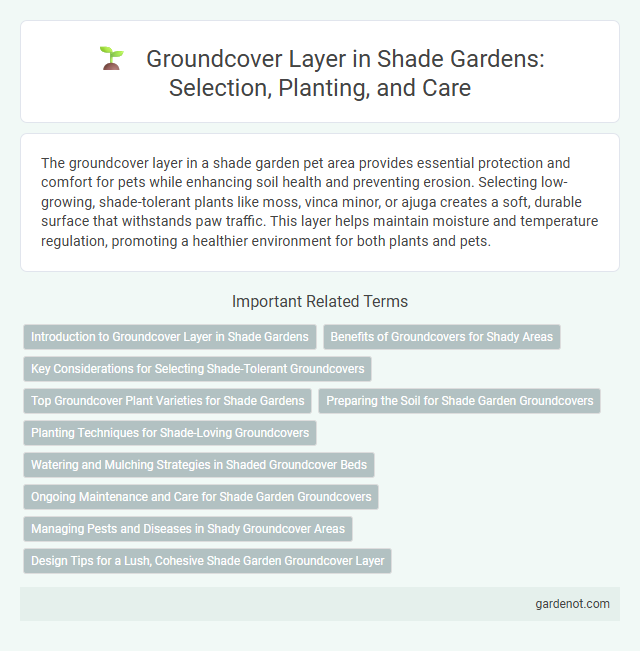The groundcover layer in a shade garden pet area provides essential protection and comfort for pets while enhancing soil health and preventing erosion. Selecting low-growing, shade-tolerant plants like moss, vinca minor, or ajuga creates a soft, durable surface that withstands paw traffic. This layer helps maintain moisture and temperature regulation, promoting a healthier environment for both plants and pets.
Introduction to Groundcover Layer in Shade Gardens
Groundcover plants thrive in shade gardens by providing dense, low-growing foliage that suppresses weeds and conserves soil moisture. Species such as hostas, pachysandra, and ajuga create a lush carpet that enhances soil health and supports ecosystem biodiversity. Effective groundcover layers stabilize the garden environment while contributing to its aesthetic appeal under shaded canopy conditions.
Benefits of Groundcovers for Shady Areas
Groundcovers in shady areas improve soil moisture retention and reduce erosion by creating a dense, protective layer. They suppress weed growth effectively, minimizing maintenance while promoting a healthier garden ecosystem. These plants also enhance aesthetic appeal with diverse textures and colors suited for low-light conditions.
Key Considerations for Selecting Shade-Tolerant Groundcovers
Selecting shade-tolerant groundcovers requires evaluating soil moisture levels, as many shade gardens have damp or well-drained soils essential for plant health. Light availability varies under tree canopies, so choosing species that thrive in low-light conditions like Pachysandra, Vinca minor, or Lamium is crucial for successful coverage. Disease resistance and maintenance needs also influence selection, with evergreen varieties often preferred to provide year-round ground protection and aesthetic appeal.
Top Groundcover Plant Varieties for Shade Gardens
Top groundcover plant varieties ideal for shade gardens include Pachysandra terminalis, known for its dense evergreen foliage and ability to thrive in low-light conditions. Other popular choices are Vinca minor, which offers glossy leaves and vibrant blue flowers, and Ajuga reptans, appreciated for its colorful foliage and rapid spreading habit. These plants enhance soil stability and suppress weeds while adding visual interest to shaded garden areas.
Preparing the Soil for Shade Garden Groundcovers
Preparing the soil for shade garden groundcovers requires enhancing soil structure and fertility by incorporating organic matter such as compost or well-rotted leaf mold. Ensuring adequate drainage and loosening compacted soil promotes root penetration and moisture retention, critical for shade-tolerant plants. Testing soil pH and adjusting it to a slightly acidic to neutral range (pH 6.0-7.0) optimizes nutrient availability for groundcover growth in shaded environments.
Planting Techniques for Shade-Loving Groundcovers
Effective planting techniques for shade-loving groundcovers involve preparing well-drained, nutrient-rich soil to ensure healthy root establishment beneath dense canopies. Employing mulching methods helps retain moisture and regulate soil temperature, vital for shade environments where evaporation rates are lower. Strategic spacing enhances air circulation and prevents overcrowding, promoting vigorous growth and reducing disease risks in shaded garden areas.
Watering and Mulching Strategies in Shaded Groundcover Beds
Shaded groundcover beds require consistent watering to maintain soil moisture levels, especially during dry periods, as dense tree canopies can limit rainfall penetration. Mulching with organic materials such as shredded leaves or bark helps retain moisture, regulate soil temperature, and suppress weed growth while gradually enriching the soil. Proper watering combined with a 2-3 inch layer of mulch promotes healthy root development and thriving groundcover plants in shaded garden environments.
Ongoing Maintenance and Care for Shade Garden Groundcovers
Regular watering and mulching are essential for maintaining healthy shade garden groundcovers, preventing soil dryness and promoting root growth. Pruning or trimming dead or overgrown foliage helps improve air circulation and reduces the risk of disease in dense shade conditions. Monitoring for pests and diseases allows early intervention, ensuring long-term vitality and aesthetic appeal of groundcover plants in shaded areas.
Managing Pests and Diseases in Shady Groundcover Areas
Managing pests and diseases in shady groundcover areas requires selecting resistant plant varieties such as pachysandra and ajuga, which naturally deter common insects and fungal infections. Regular monitoring for signs of pests like slugs, aphids, and fungal diseases including powdery mildew ensures early intervention with organic treatments or insecticidal soaps. Improving airflow and maintaining well-drained soil beneath dense groundcover layers prevents moisture buildup that fosters disease development in shade gardens.
Design Tips for a Lush, Cohesive Shade Garden Groundcover Layer
Select shade-tolerant groundcovers like Pachysandra terminalis, Vinca minor, or Lamium maculatum for dense, low-maintenance coverage. Arrange plants with varying textures and heights to create visual interest and promote healthy growth, ensuring soil is well-drained and enriched with organic matter. Incorporate mulch to retain moisture and suppress weeds, fostering a vibrant, cohesive groundcover layer that thrives in shaded garden areas.
Groundcover layer Infographic

 gardenot.com
gardenot.com